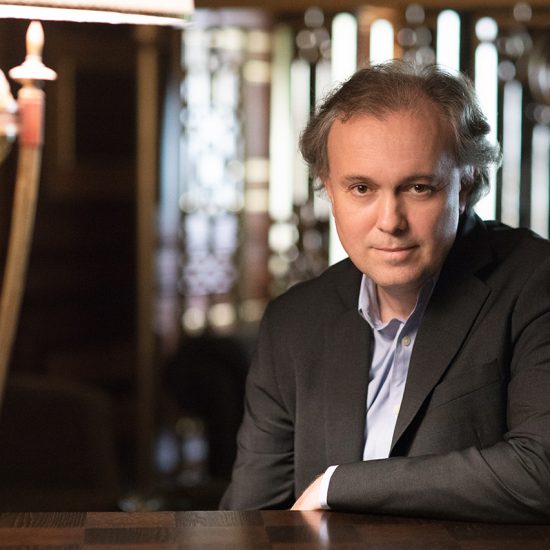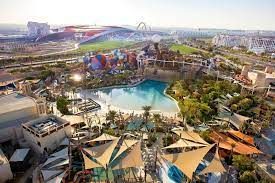
The cast of artists, curators, architects and academics who assembled to speak at this year’s Abu Dhabi Art are doing so, primarily, with local or regional themes as their focus.
Idris Khan, the British artist behind the UAE’s new national memorial, is speaking about his role in the project, and the Italian sculptor, Giuseppe Penone, is talking about his commission for the new Louvre Abu Dhabi, while Valerie Hillings, the curator and manager of the Guggenheim Abu Dhabi project, has been asked to reflect on the life and work of the recently-deceased Emirati artist Hassan Sharif.
It is, however, the appearance of two men with a very international perspective and no immediately obvious connection to the country that proved to be one of the most anticipated events.
The conversation between Okwui Enwezor and David Adjaye, which is taking place on Friday November 18, is as much a meeting of old friends as a discussion between a renowned curator and a designer who, since the opening of his new Smithsonian National Museum for African American History and Culture in Washington, DC, might reasonably claim to be the world’s most high-profile architect.
Adjaye, a 50-year-old British-Ghanaian who was born in Tanzania, has already worked with Enwezor, a 53-year-old Nigerian, twice since 2014.
As well as designing several of the gallery spaces for the 2015 Venice Biennale, for which Enwezor served as artistic director, Adjaye also advised on the design of the exhibition Form, Heft, Material, a survey of his work that was co-curated by Enwezor for Munich’s Haus der Kunst, the museum the Nigerian polymath currently directs.
Adjaye not only considers the poet, critic and historian to be a friend but is also on record as regarding his close contemporary as his “intellectual barometer”.
“For me it’s always an incredible pleasure to work with him, and that working relationship is seamless because it’s never about ego,” the architect explains to me a few days before the pair are due to meet in Abu Dhabi.
“It’s about the exchange of ideas, and what’s lovely about having a friendship with Okuwei is that it’s possible to work through ideas and he will raise a red flag if they’re ever going wayward,” says Adjaye speaking from New York, where has spent an increasing amount of time since winning his first public commission in the United States, the Museum of Contemporary Art in Denver in 2007.
“Okwui’s one of those great intellectuals and thinkers who always has the overview and who never lets you forget the grand arc and breadth of history and about the way certain narratives might be playing out in the contemporary condition.”
It’s those broader considerations, rather than his recent work on the African-American museum, that Adjaye was keen to discuss ahead of his talk in a place where, thanks to the as-yet-unrealised plans for the Saadiyat Island Cultural District, thoughts of the future are unavoidable, especially when it comes to museums.
“With a museum, the question is no longer whether it’s an expensive, high-tech box for a load of objects that are codified as precious,” Adjaye insists. “It’s whether there’s a narrative that underpins the institution that can be interpreted through the architecture to further the experience.”
With the African-American museum, a building the architect admits is likely to be the most important of his career, Adjaye has attempted to redefine the museum by reconsidering the assumptions that underpin it. On Washington’s National Mall, this means rejecting the idea of a people’s palace. “Before the Enlightenment the palace was the one place that common folk couldn’t get into, a place of wonder and power that they’d never had access to before. But it came to be seen as a typology that could help people access the wonders of the world,” he explains, describing a process that began during the French Revolution when the Louvre was originally transformed from a palace to a public museum.
“But in the 21st century, and especially in the digital age, the palace is in one’s hand, it’s no longer a space that you need to go to that codifies power and knowledge.”
The technique of looking for new models, not just for buildings but for public spaces and even for civil society, is an approach that Adjaye first adopted more than a decade ago when designing libraries, which he reimagined as Idea Stores, for the London Borough of Tower Hamlets.
At the largest, in Whitechapel, Adjaye not only attempted to dissolve the boundary between the building and the street by employing a transparent facade, he also enveloped the adjacent pavement in an atrium while creating spaces for a new kind of information centre that was part youth club, part living room, part dancehall and shop.
Much has been written about the way Adjaye’s design for the African-American museum echoes the metalwork created by slaves in the states of the antebellum American South and the way its facade, an inverted stepped pyramid, references traditional forms of African architecture, but the architect also looked to some of the Modernist masterpieces that line the National Mall such as Gordon Bunshaft’s Hirshhorn Museum (1974) and IM Pei’s East Building for the National Gallery of Art (1978).
“Up to the moment that Gordon Bunshaft creates the Hirshhorn it’s a narrative, figurative architecture that’s [built] along the Mall,” Adjaye explains.
“It’s neo-classical, it’s neo-Gothic, it’s arts and crafts, which are all revivalist and figurative arts, but then you have the Hirshhorn and you see a contextual response from IM Pei where the public space almost becomes as big as the museum space.”
Adjaye sees his Smithsonian, the last for which there is space along the National Mall, as part of a triumvirate that includes the Hirshhorn and the East Building because of the way in which he has attempted, like Bunshaft and Pei, to reimagine how a museum might work.
In the way that Bunshaft created a museum that Adjaye describes as a “technological abstraction, a pavilion that is primarily a machine for art”, Pei, for Adjaye, investigated the use of public space because of his insight into the new ways the public had started to engage with culture, an idea he went on to explore again with his design for the Louvre Pyramid in Paris.
Adjaye’s contribution to the National Mall, as he sees it, is to have created a thoroughly American building that represents a new form of abstraction, one that is informed by the lessons he learned during the decade he spent looking at buildings in Africa, a place he refers to as “the Continent”.
Over a 10-year period, Adjaye visited 53 major African cities, amassing an archive of 40,000 photographs of buildings, sites and places that he then re-organised according to the geographical and climatic environments in which they were created: maghreb, desert, sahel, savannah, grassland, mountain, forest and highveld.
“The building is a direct reflection of what I call forest architecture and abstraction that comes directly from the Continent,” Adjaye says.
“It is a root-based building, a tripartite structure that deals with the history, the root, and which then provides an overview, which is the way that history informs the present and then looks at the future, to the important horizons in the immediate context of Washington and the [National] Mall.”
Africa has taught Adjaye two of the most crucial lessons which he finds applicable to architects and buildings throughout the world. They are the ways in which buildings there embody and reflect the culture and the environment that they are the products of, and what he sees as a peculiarly African approach to complexity, abstraction and to an understanding of a sense of culture and place.
“Even with very little high-end architecture, humanity’s response in those conditions and in those cultures has a profound set of lessons to talk about the way in which, with any materials at the hands of those communities, they express the nature of place,” he says.
“The Continent offers a profound ability to see the very act of building with societies. It’s not just the act of building on its own in response to a desert, it’s the act of building through the civilisation of a people who have lived in that place for several thousand years. There’s an inherent emotional memory that’s being carried through continually within these groups.”
Adjaye balks slightly at the suggestion that the regional African architecture he values is one that embodies a form of vernacular wisdom. As the phrase, he suggests, places too much emphasis on the craft of building, but what he is clear about is the opposition between his approach and the kind of architecture that has come to dominate the profession emerged in recent decades.
There have been years, Adjaye insists, when his colleagues in the profession have become too enamoured with what he describes as architecture “with a capital ‘A’” and have lost sight, not just of what he sees as the profession’s responsibilities, but also of its potential.
“With technology in the 20th century and now still with digital technology in the 21st century, architecture has become obsessed with technique and the ability to decouple itself from the very purpose and agenda – what I mean by the responsibility – of what it does. It practises itself almost as an art form independent of humanity,” he says. “The architecture of the 21st century should move beyond a fascination with technology to a use of technology to deal with the complexity of the time that we’re in.”
For Adjaye, good architecture displays responsibility by reflecting the communities and geographies that produce it, creating a form of construction that is more than a response to market forces or to the opportunity to build.
This is a lesson, he insists, that can be learned from Africa, and one of the people that Adjaye thanks most for his revelation is his friend and intellectual mentor Enwezor. “What’s in that revelation is the idea of how the continent is able to deal with complicated ideas, of narratives of place, of peoples, of kingdoms, of geographies and of stories, into a series of abstractions that create very powerful collective emotional forms … half a millennium before the Europeans even came to us,” he says.
“That information isn’t just for Africans: it’s a very powerful piece of knowledge that the world does not, and has not, used and for me, in my own work, I find that resource is such a fertile space to deal with the complexity of the contemporary metropolitan and cosmopolitan world.”
Abu Dhabi Art is taking place from November 16 to 19 at Manarat Al Saadiyat. ‘Okwui Enwezor and David Adjaye in Conversation’ is being held in the auditorium on Friday November 18 at 6pm. For more programme details and to register, visit www.abudhabiart.ae.
Nick Leech is a feature writer at The National.








